I use a variety of containers in my garden, but over the years I’ve narrowed the types of containers I use at different stages of development.
Here are some common options for our trees and some of the reasons why we might want to use them at a given stage of their development.
Plastic containers
Anderson flats
Many great bonsai get their start in plastic pots. I use a special type of plastic pot known as an Anderson flat for sprouting seeds, rooting seedling-cuttings, or establishing roots on bare-root liners (young sprouted seedlings).
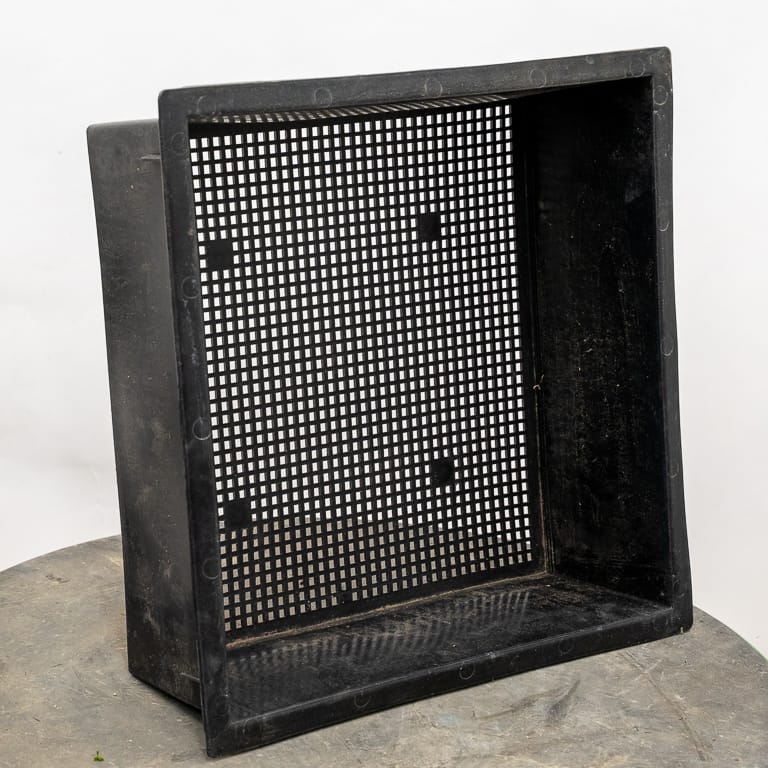
Anderson flat
Anderson flats are great because the bottom surface is mesh. The mesh supports increased air circulation and can reduce fungal problems in the roots.
Anderson flats are also a good option for field-grown or collected trees as the width to depth ratio is similar to what we find in bonsai containers.
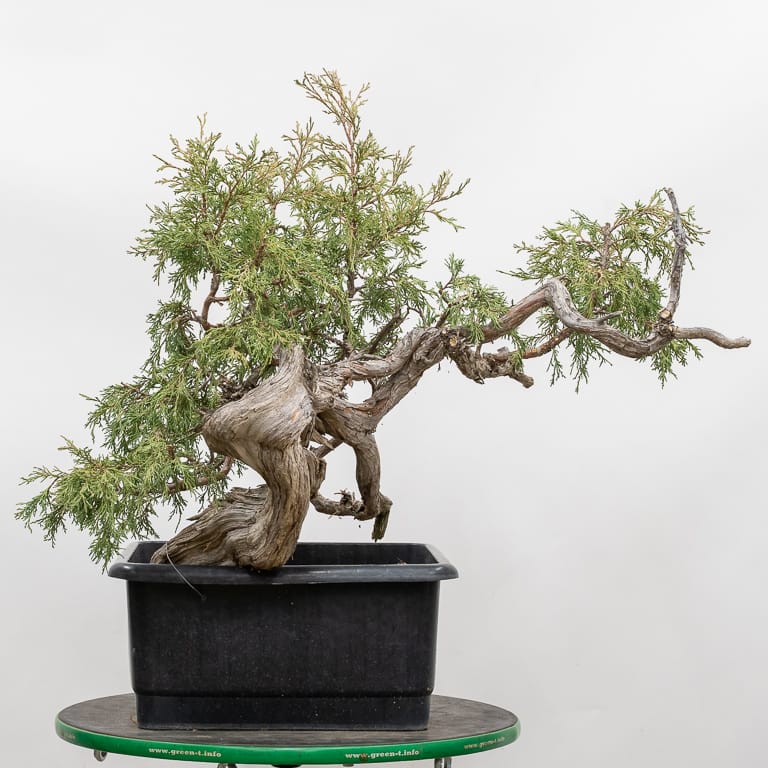
Rocky Mountain juniper in an Anderson Pot
Nursery pots
In general, I use plastic nursery containers for my youngest trees. Nursery containers are inexpensive, square or round, and can be flexible or sturdy.
When selecting nursery pots for young trees, my main criteria is whether or not they fit neatly into flats that will prevent them from falling over.
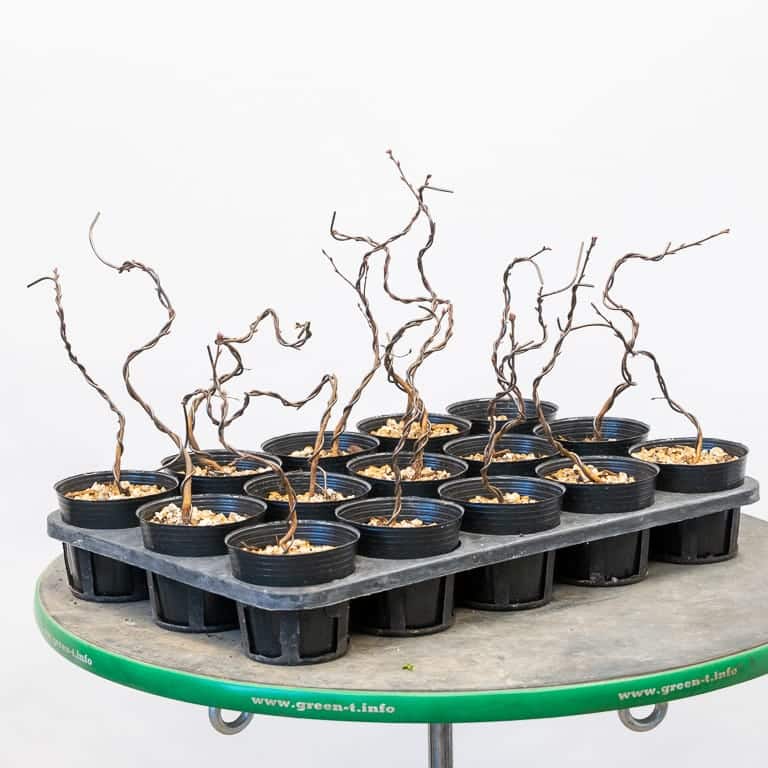
Hornbeam seedlings
Most nursery pots are deeper than they are wide, but this can be a good thing as young trees generally grow quickly and can benefit from the extra moisture that deeper containers offer.
Larger plastic containers are also good for trees in the early stages of trunk development or for trees that have recently been dug from the field.
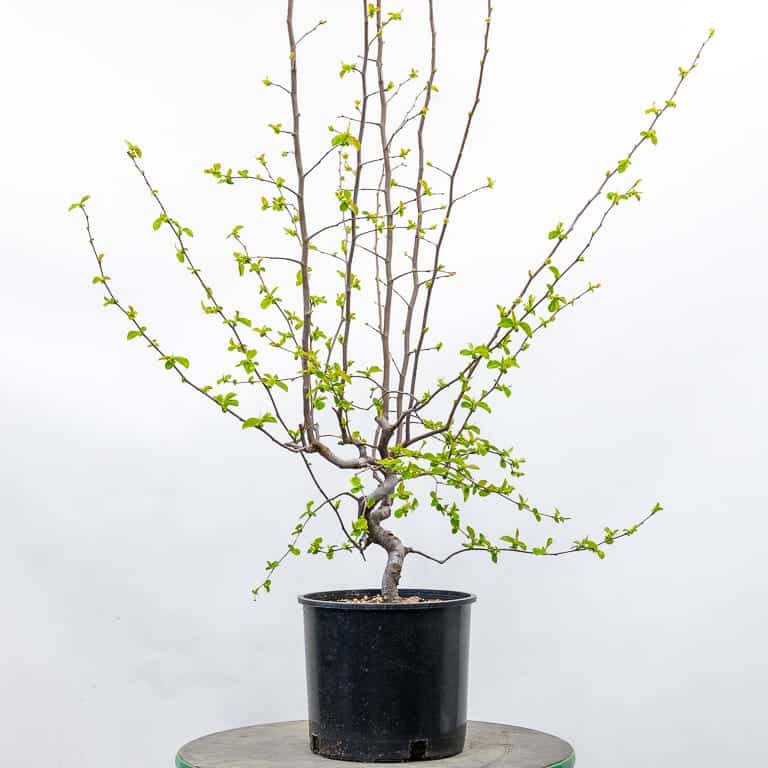
Container-grown Chinese quince
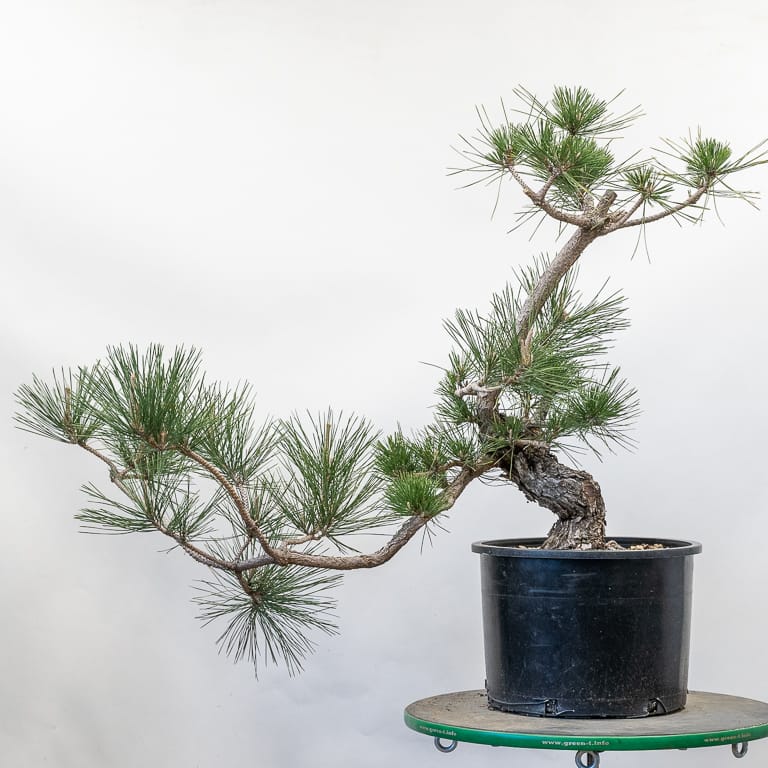
Field-grown Japanese black pine
Perforated containers
Some of my favorite options for developing trunks quickly are containers with lots of perforations. The best example of these are colanders.
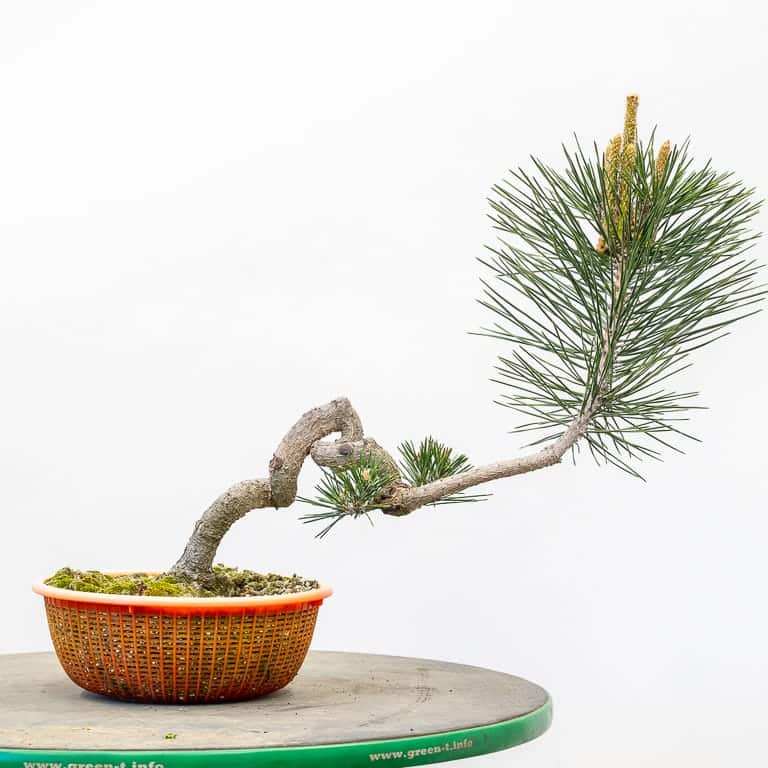
Black pine in a colander
Plastic colanders are inexpensive, shaped like bonsai pots, and easily available in Asian grocery stores or online kitchen supply stores. More importantly, they possess the same magic characteristic for developing great roots that Anderson flats have.
When a fine root reaches the side of a colander, the root tip dies. This causes increased lateral root development that makes colanders perfect for species like pine where ample fine roots near the base of the trunk help create the flared base we appreciate in pine bonsai.
Pond baskets are colander-like containers that offer the same benefits but come in different shapes.
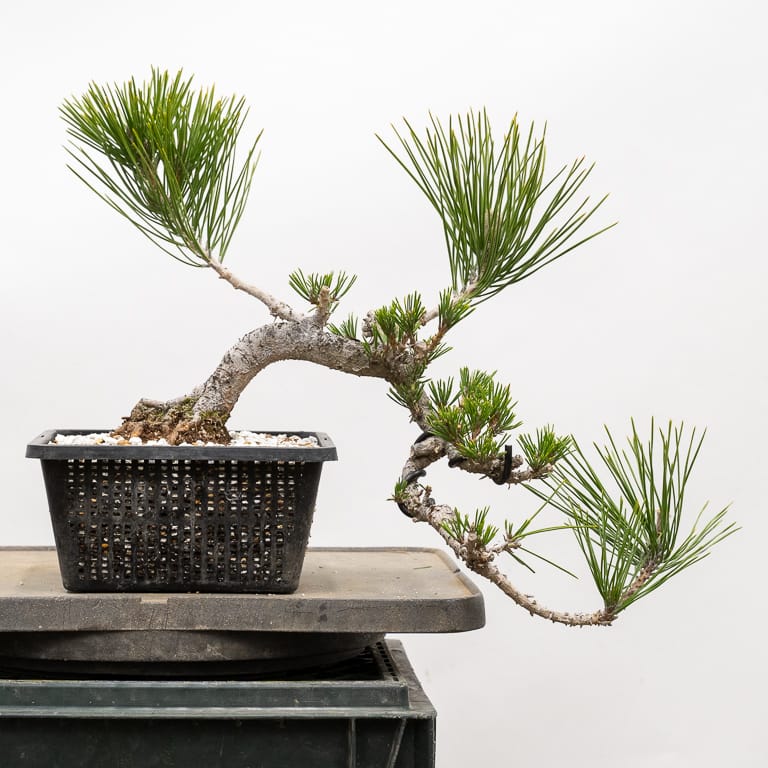
Black pine in a square pond basket
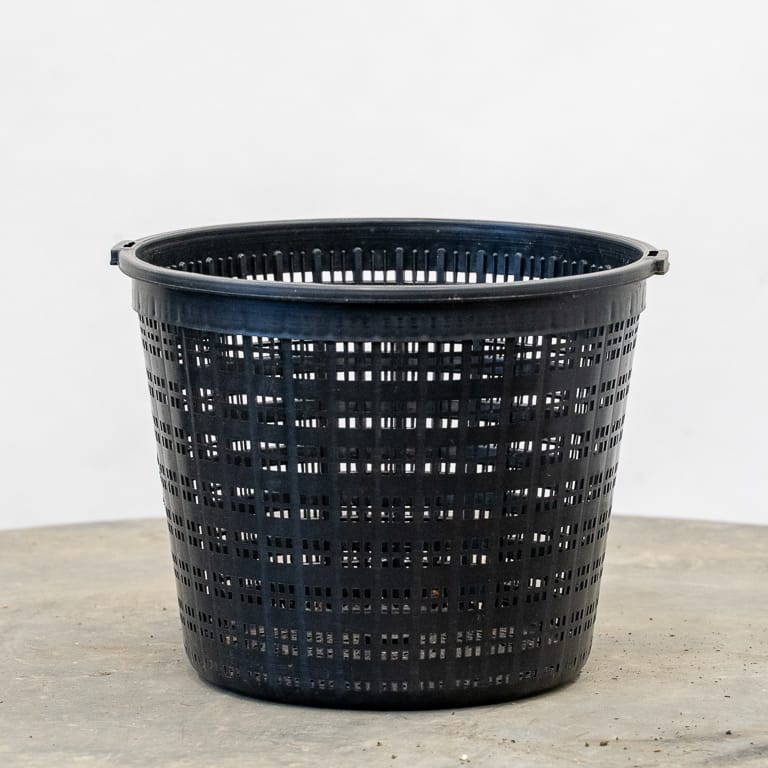
Round aquatic basket
The main benefit of pond baskets over colanders is that they last much longer. Colanders typically last two-to-three years in full sun whereas pond baskets can last five-to-ten years.
For trees in the later stages of development, I move away from plastic pots toward containers made from wood or clay.
Terra-cotta containers
Terra-cotta pots are a convenient option for a variety of uses. I use them for recently collected trees, trees that were bare-rooted, and trees that aren’t quite ready for their first bonsai pots.
The field-grown shimpaku below was planted in a large plastic pot when it came out of the ground. I used a terra-cotta pot for the tree last year as the roots don’t yet fit into a bonsai pot.
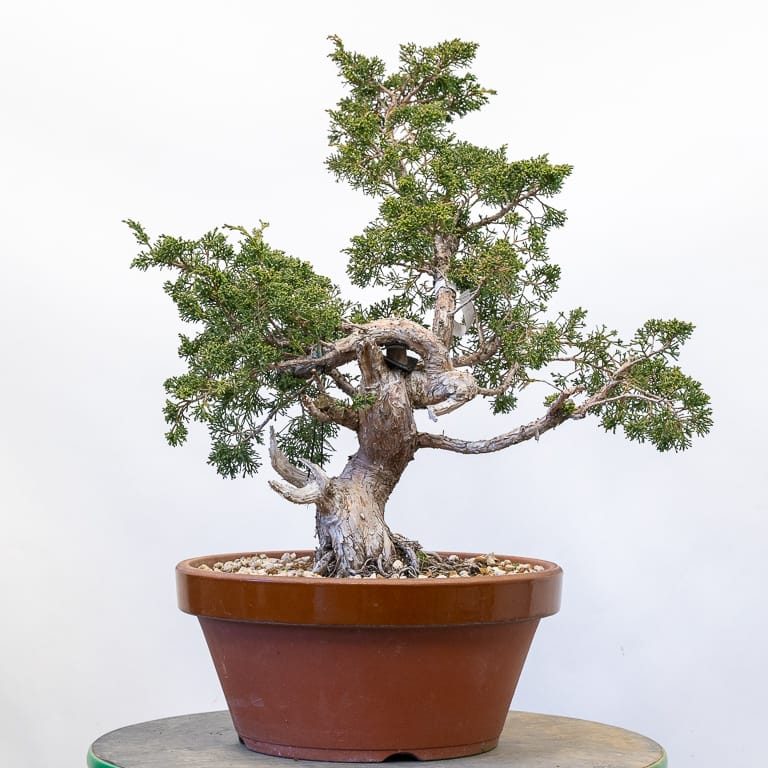
Kishu shimpaku
The juniper below is also a few years out of the ground. Its roots were compact so I was able to fit it into a much smaller container.
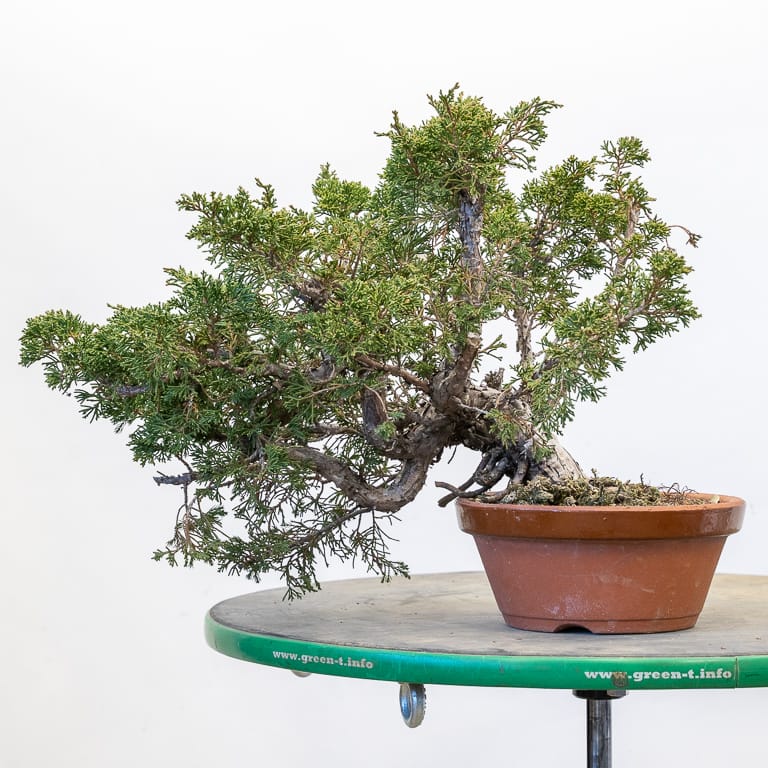
Future shohin itoigawa juniper
The proportions of terra-cotta pots are also a great fit for azaleas that have been bare-rooted. The extra depth provides moisture for the roots and gives them space to grow for the two-to-three years that’s needed for them to reestablish their roots.
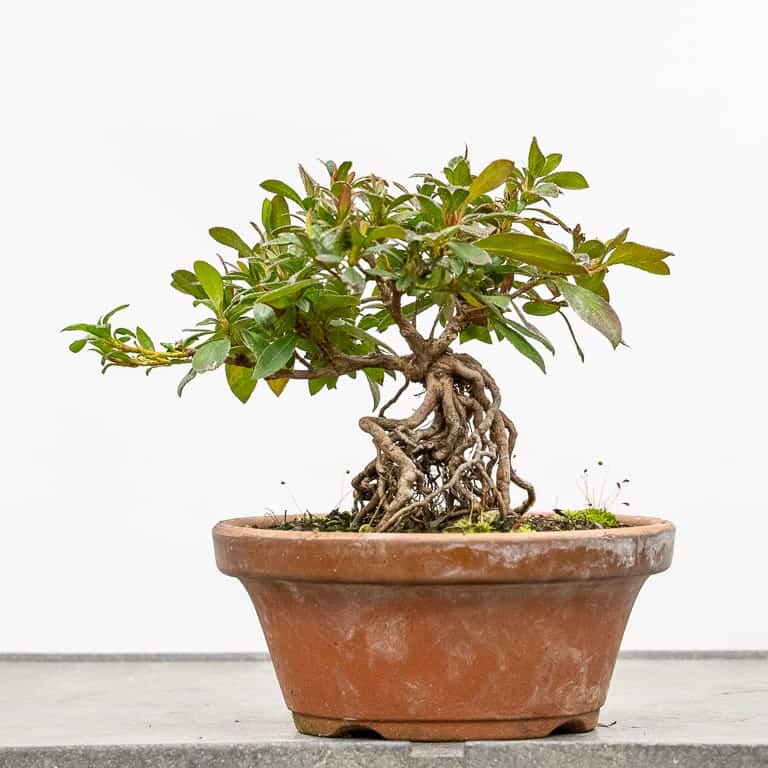
Exposed root satsuki azalea
Many of my pines move from colanders to terra-cotta pots once the trunks have reached the desired thickness and it’s time to focus on branch development.
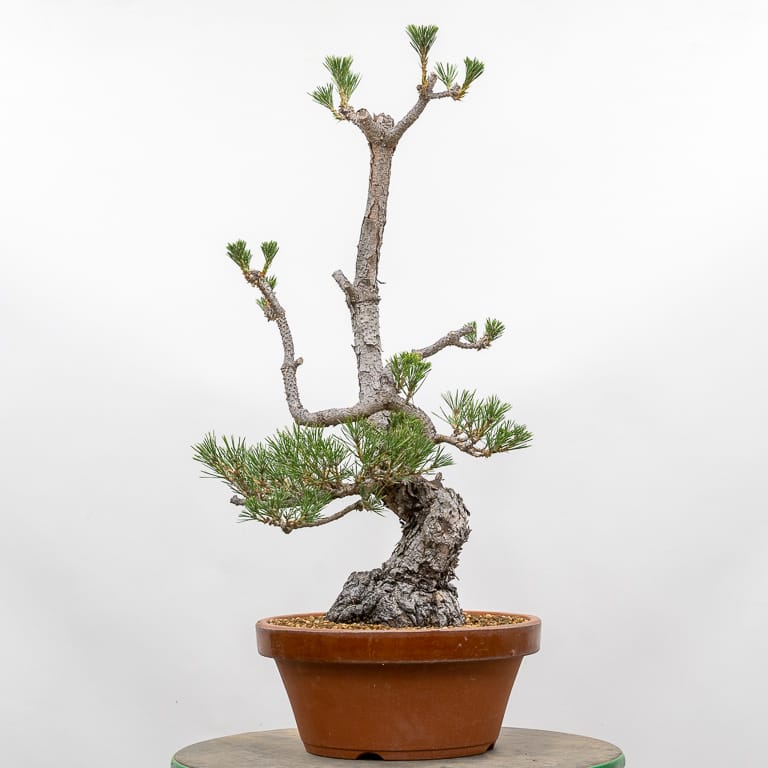
Black pine with sacrifice branches
Wood boxes
The primary benefit of wood boxes for bonsai is that we can create custom containers that are just the right size for our trees.
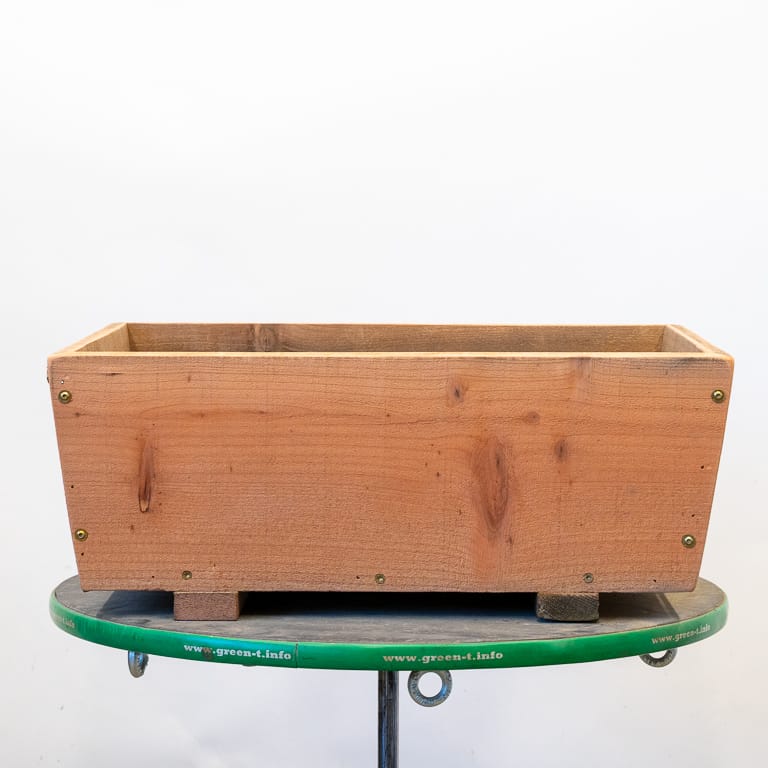
Redwood box (thanks, Dad!)
Deciduous species do well in low and wide containers that promote lateral root development.
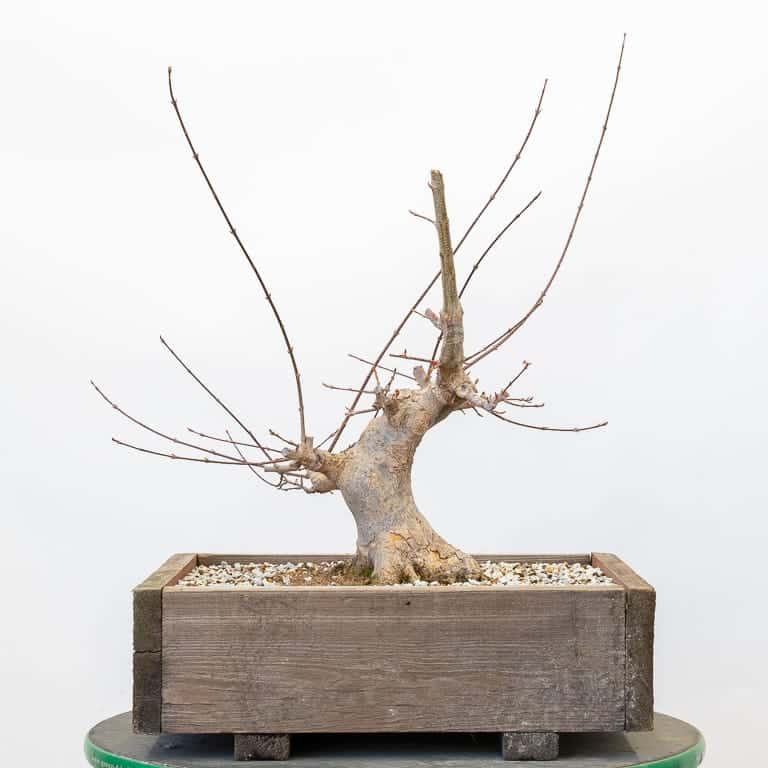
Field-grown trident maple in a wood box
Boxes are also a fantastic option for refined trees that have lost vigor. By creating a slightly larger box, we can give trees room to grow for a few years while they regain their vigor.
Bonsai pots
When I first move a tree into a bonsai pot, I usually select a container that’s inexpensive and/or slightly too big for the tree.
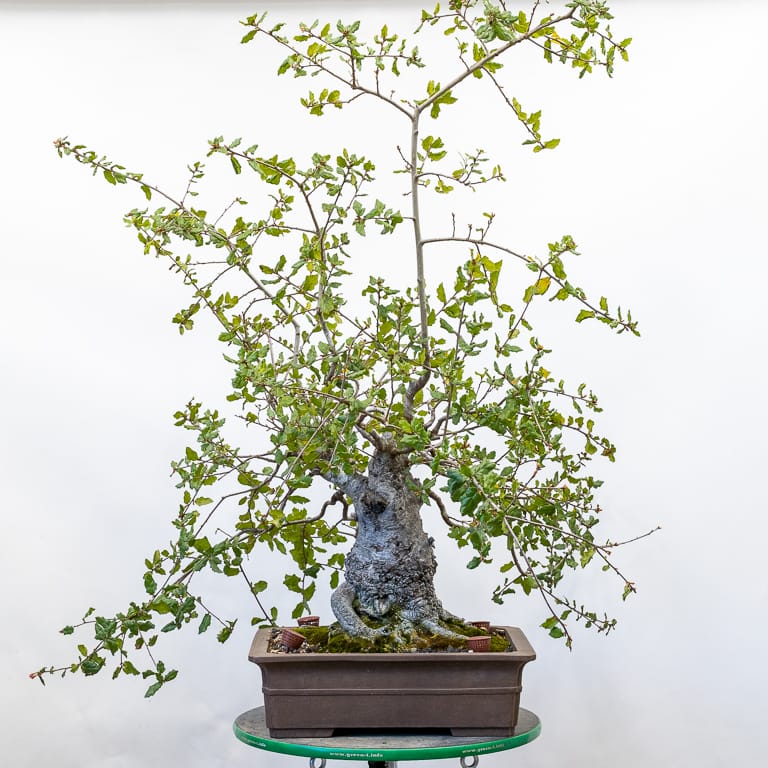
Coast live oak in an unglazed bonsai pot
I don’t worry too much at this stage about selecting quality containers or getting the style just right because I have no interest in showing the tree for several years. Once the branches are further refined, I’ll try to find the best available container for a given tree.
This is where the real fun begins. I’ve shared a number of posts featuring photos of different pots for the same tree in an effort to convey the effect a container can have on our perception of a tree (see “Pot selection exercises” for links to these posts).
This is also the aspect of container selection that gets the most attention, so for now I’ll note how satisfying it can be when you find the right container for a tree. Here are two examples where I have yet to find a perfect match.
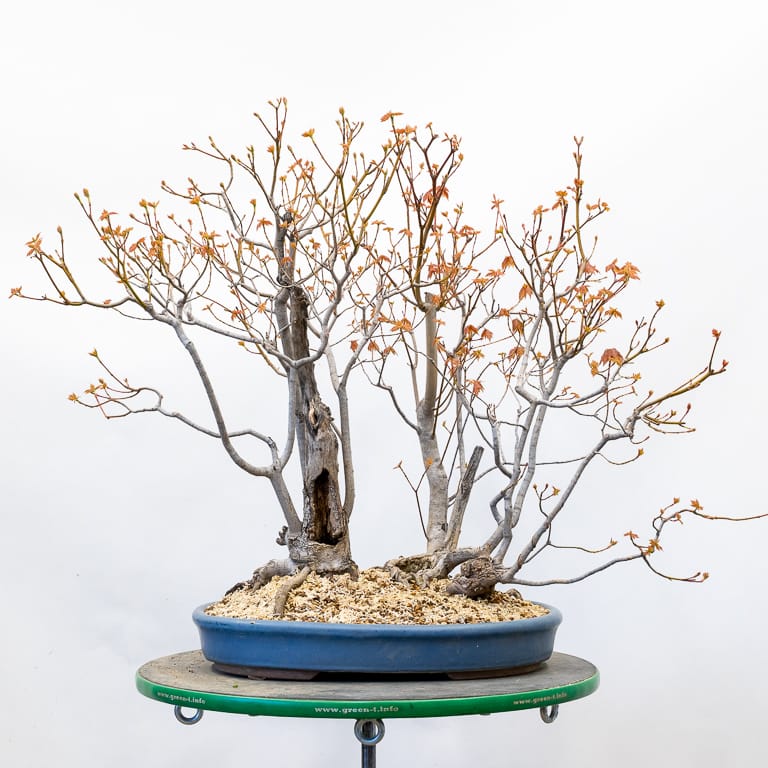
Red maple in a shallow blue oval

Plum group planting in an off-white oval with beveled sides
There is a lot more to say about bonsai containers. Please share any questions or suggestions you have for the topic in the comments below.
Thanks to Cheryl for suggesting the topic!
Bonsai Tonight Updates
- Check out the latest episode of the Bonsai Wire Podcast in which Michael Hagedorn, Andrew Robson, John Eads and I discuss all things repotting. It’s our most technically-focused episode yet.
- If your club is looking for a presentation on repotting bonsai, I’ve recently created a program in which I provide live narration to accompany video from the repotting of a mature beech forest. Feel free to call or write with any questions about the presentation.
Subscribe to Bonsai Tonight
New Posts Delivered Every Tuesday and Friday
Pascal GRADT says
Hy,
Have you try the ROOTS’ STAR pot , with the Airpot technology
https://www.lescompagnonsdubonsai.com/equipement/les-pots-de-culture/
Jonas Dupuich says
Hi Pascal – I’ve seen these but I haven’t used them yet. I assume they produce nice roots like pond baskets and colanders do which would make them good for the rapid trunk development phase. I’ll have to give them a try someday!
Pascal Gradt says
yes you should because with this technology, go see on the website (translation in English also) to see the advice sheets because I think that this technology goes much further than the colanders or pond baskets
Pascal GRADT says
see the last video,sorry it is ibn french but youy can see the flat nebari that they produced
Jonas Dupuich says
Thanks for the additional links – I’m curious to see how they compare with the other options!
Cheryl McAlister says
Hurray!!! Thanks, Jonas!
Jonas Dupuich says
Thank you!
Thomas Tynan says
Great post Jonas…I like to screw into the bottom of the Anderson Flat a couple of pressure treated 1 x 2 the full width of the square flat; that way they always sit slightly off the bottom of the surface. Sometimes I also use a piece of plain window screen in the bottom of the flat and then my soil mix as the square openings let alot of soil thru the square holes; regards Tom
Jonas Dupuich says
Thanks, Tom! That’s a good idea – if the flats sit directly on a wood bench much of the benefit of the mesh-bottom pots is lost. The same goes for colanders too.
Window screen makes sense for the bottom of the flat as the mesh openings are pretty big. I usually use large pumice which also helps with aeration at the bottom of the pot.
Andrew Gutierrez says
Hey Jonas,
Another super insightful post.! Thank you for helping us becoming better bonsai practitioners. I’m curious when you have these trees in a variety of containers, are they also in a variety of media mixes? If a tree is in early development in a nursery pot, is best to have more or less moisture for growth?
Jonas Dupuich says
Thanks, Andrew! Yes, I use a variety of mixes. When it comes to younger trees, I tend to use mixes that hold less moisture. For example, I rarely use more than 30% akadama in mixes for young trees, and 80% pumice 20% mulch is a common akadama-free alternative.
Andrew Gutierrez says
Wow, thank you, Jonas. I met you in November and since then, I either read your blog/book or listen to Bonsai Wire daily. I really enjoyed the most recent podcast about repotting. I’m 2 years into my bonsai career and I’m thankful for the learning material you provide for all levels bonsai enthusiasts, especially for a beginner like myself.
James Scott Chadd says
i am using the same systems, with the exception of colanders, they seem to not go much over a year for me. we don’t want the Anderson band pots to drain well so much as we want the roots to grow through the holes and into the earth below, we place them on the ground.
Jonas Dupuich says
Letting roots grow into the ground is another great benefit of perforated pots. You get the benefit of rapid growth but it’s relatively easy to “dig” the trees by severing the roots below the flats when it’s time to work on the trees. It’s also nice that trees need less water once they’re rooted into the ground.
Jeff Douglass says
Thank you Jonas
I wonder why the fine roots die when they touch the side of the colander, as opposed to touching the side of a pot?
It seems the difference is that there is an air interface vs a wall interface. So maybe in the colander, the root grows to/through the perforations then quickly is exposed to open air and so stops/dies without a chance to reroute left/right (as within a pot). Then the root growth sends out new lateral roots to keep the advance going?
It is an interesting process; thanks for pointing it out.
Jonas Dupuich says
Thanks, Jeff! I think it’s the air that makes the difference. By cutting down on circling roots, the colanders can create really dense root balls that really ease the transition to bonsai containers when the time comes.
Plastic pots may yield lots of roots, but these roots are less useful as they tend to be coarser and will all be cut when the tree is next repotted.
Kevin Williams says
Great post Jonas! I’ve been testing a few fabric pots lately with very good results. You still get the air pruning effect as the roots do grow through, and you can adjust the height by folding down the rim to meet the size of the root ball. They’re also reasonably priced, fold flat, and hold moisture a little better than slotted pots. I’d be interested to see them in a side by side comparison. Thanks for the post.
Jonas Dupuich says
Thanks, Kevin! I forgot to mention fabric pots as I have limited experience with them. I’m planning to use some this year so I hope to share the results before too long.
Tino M says
Hi Jonas,
I love the incredible depth and clearness of information you give!
Question :what is the advantage of the terracotta phase?
I think air pruning is more about moisture or the lack of it at the edge of the pond baskets/colander.
Jonas Dupuich says
Thanks, Tino! I think that’s right about air pruning with the colanders and pond baskets. As for the terra-cotta, they offer more structure than plastic containers which allows the tree to be well secured in the pots. They also strike me as less prone to encouraging circling roots. More importantly, they are closer in size to bonsai pots – a little wider and less deep than most nursery containers for a given volume of soil. Terra-cotta containers imported from Japan also feature a large drainage holes and additional holes for tie-down wires which speeds repotting.
If the roots of a tree are such that they fit bonsai containers well, I’ll often move trees from plastic containers directly to bonsai training pots (inexpensive unglazed pots for bonsai).
Henry N says
Hey Jonas, I am part of the MN bonsai society. I watched your lecture and discovered this site. I have noticed with many of yours and others’ group plantings that at the top of the desired height they lose the taper or turn off to the side. They sometimes also completely change the theme of their canopy. What causes this and is it a solvable problem?
Jonas Dupuich says
Hi Henry – great question! Some turning off toward the apex is natural as that’s how deciduous trees grow naturally. That said, when we try this with bonsai the results aren’t always graceful. Letting the trunk grow thick and cutting back to much smaller branches is a primary cause of this turnoff. Pruning the apex before it gets too large is one way to avoid this. Another option is to cut back to a smaller branch and then letting that branch grow out for a longer distance (making a larger tree).
I have yet to make a deciduous forest planting from scratch so these are the exact things I’m dealing with when I think of improvements to the forests I’m currently working with.